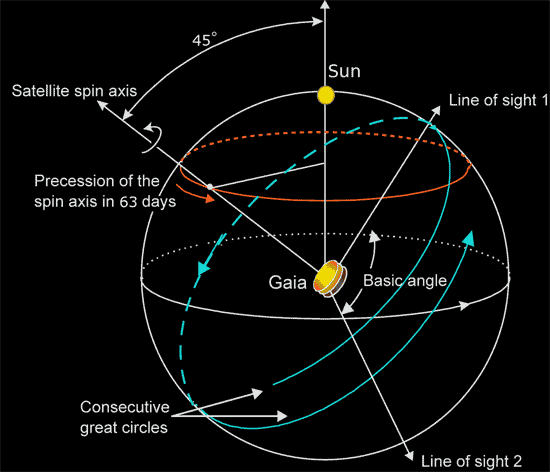
Gaia observation principle. The measurement principle used by Gaia relies on the systematic and repeating observation of the star positions in two fields of view. For this purpose, the spacecraft is slowly rotating at a constant angular rate of 1° per minute around an axis perpendicular to those two fields of view, which thus describe a circle in the sky in 6 hours. With a basic angle of 106.5° separating the astrometric fields of view, objects transit in the second field of view 106.5 minutes after crossing the first one. The spacecraft rotation axis makes an angle of 45° with the Sun direction. This scan axis further describes a slow precession motion around the Sun-to-Earth direction, with an average period of 63 days. This allows the scanning law definition to be independent from the orbital position around L2. (Image courtesy of Jos de Bruijne & Karen O'Flaherty / ESA 2012.)
The Gaia mission design builds on ESA's successful Hipparcos mission, which operated between 1989 and 1993. The telescopes used in both missions have unique design of two fields of view separated by a large angle, with which the sky is systematically scanned. This design, first pioneered by Prof. Lacroute in France in the late 1960s, allows for the large-scale measurement of absolute stellar distances.
The scanning of the sky has to compromise between two sets of opposing requirements. Operation of the satellite requires a very constant thermal environment. The minimum provision to achieve this is to keep constant the solar aspect angle. This is the angle between the direction of the Sun and the satellite's spin axis as seen from the satellite. To optimize the energy produced by the solar panels, and to keep direct sunlight away from the telescope apertures, the solar aspect angle should be small. But to obtain good scan coverage the same aspect angle should be large. It is therefore not surprising that angles of 43 and 45 degrees have been selected for Hipparcos and Gaia respectively.
The spin axis is set to precess 6.4 times per year around the direction to the Sun. This is combined with a rotation period of just over 2 hours for Hipparcos, and 6 hours for Gaia. The spin and precession together deliver at least two transits in different directions for all parts of the sky every 6 months.
The "Nominal Scanning Law (NSL)" animation below shows an accurate simulation of the Nominal Scanning Law (NSL) of Gaia during its 5 year nominal mission in 2-dimensional Hammer-Aitoff projection. The animation was created by Berry Holl (Observatory of Geneva) using plotting routines developed by Francesca De Angeli. Additional information about the simulation can be found on the animation page on YouTube. (Skip video.)
Next: The Hipparcos mission
Page last updated: 26 August 2014
